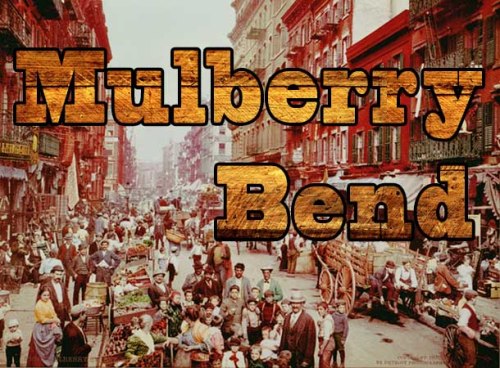
Address: Mulberry Street Between Worth and Bayard Streets
Status: Partially Demolished in 1897 Now Columbus Park
A maze of back alleys and hidden passageways, the Mulberry Bend on Mulberry Street was a gathering place for generations of New York’s underworld. From the Dead Rabbits to the Gambino Crime Family, the Bend’s horrific conditions served as an incubator for the gangs of New York. Today, only a tiny sliver of this infamous neighborhood still exists.
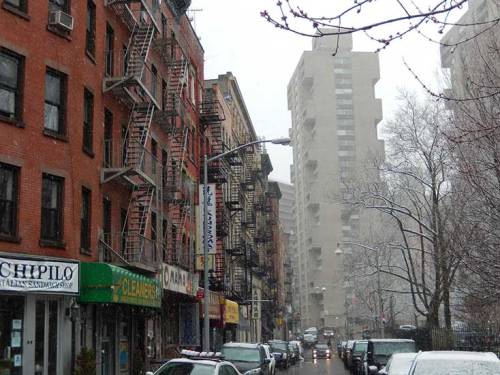
All that remains of Mulberry Bend today, is a tiny sliver of land on the east side of Columbus Park.
According to 19th century social reformer Jacob Riis:
“Where Mulberry street crooks like an elbow within hail of the old depravity of the Five Points, is “the Bend” foul core of New York’s slums.”–Jacob Riis, How the Other Half Lives
Mulberry Street was the aorta that pumped life though the slums of the Five Points. Located between Worth and Bayard Streets, The Mulberry Bend was a place where the poorest of the poor scrambled to survive. A home for the unwanted and unwelcome, the street existed as a multi-racial, multi ethnic, polyglot community, unplanned and predating the city’s grid system.
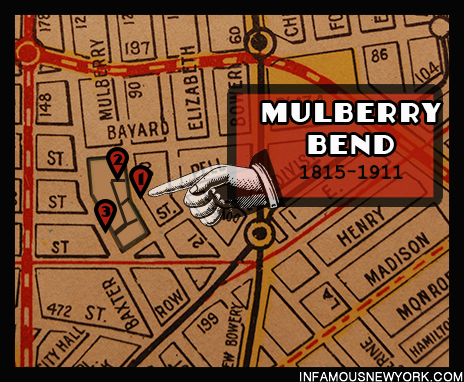
The Mulberry Bend. 1)Ragpicker’s Row 50 ½ Mulberry Street 2) Bandits Roost 59 ½ Mulberry Street. 3) Bottle Alley 47 Baxter Street.
From Country Lane to Urban Slum
In the days before the American Revolution, the street was named for a grove of Mulberry trees on the banks of the Collect Pond, one of Manhattan’s freshwater reservoirs. The Pond’s marshlands forced engineers to route the country lane in a west to east bend, which would become Mulberry Bend.
By 1810, Mulberry Street became urbanized. Heavy industry congregated around the Collect Pond. Slaughterhouses, potters and blacksmiths choked the shores of the Collect, while raw sewage from the slums of Mulberry Street ran into the water, transforming the pond into a polluted bog.

The freshwater Collect Pond quickly became a toxic bog. It was drained in 1817 and became the Mulberry Bend.
In 1817 the City Council drained the pond by digging a canal, which still runs under Canal Street today. The city then filled and graded the empty pond and Mulberry bend was born.
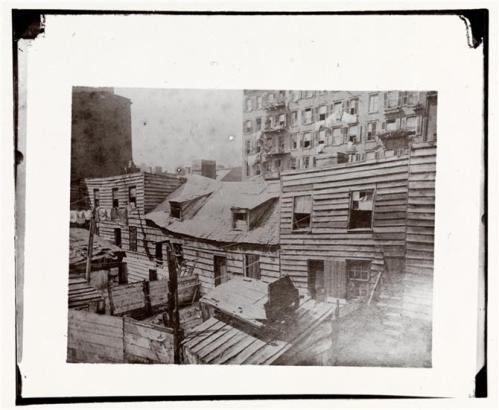
Mulberry Street was a gathering place for generations of New York’s underworld. Image via Museum of the City of New York
The Bend
By the time of the Potato Famine, the Bend ranked as one of the densely populated urban areas in the world. For most of the 1800s the Bend’s population consisted of Irish immigrants and free African Americans, but by the 1880s an onrush of Italian overtook the squalid streets. Day and night on the bend, peddlers hawked stale bread, questionable meats and stolen goods.

The slums of Mulberry Bend in the heart of the Five Points. Image Via the Museum of the City of New York.
Squeezed by landlords and forced to live in apartments crammed well beyond capacity, diseases wracked the neighborhood annually, accumulating an astronomical infant mortality rate. In 1888, over 3,000 infants died on Mulberry Street before reaching 6 years of age.
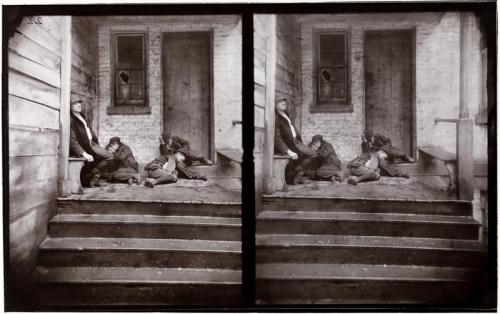
Mulberry Bend was the epicenter of incredible poverty. Image via the Museum of The City of New York.
The poorest in the Bend, lived and worked in maze of back alleys stretching over to Baxter (then Orange St.) Street. With few options and little hope, it’s no wonder the denizens of the Bend’s back alleys turned to a life of crime.
The Mulberry Underground
A warren of hidden passageways and back alleys, with insidious names such as Rag Picker’s Row, Bandit’s Roost and Dynamite Alley, the underworld utilized the ramshackle architecture of the Bend to their advantage, hiding from both the police and sanitary inspectors. According to Jacob Riis:
“The whole district, is a maze of narrow, often unsuspected passageways-necessarily, for there is scare a lot that has not two, three, or four tenements upon it, swarming with unwholesome crowds.”–Jacob Riis, How the Other Half Lives
Rag Pickers, the lowest echelon of New York society, congregated in Rag Picker’s Row, another of the Bend’s enclaves where they would collect their rags scavenged from the city’s trash. Nearby at 50 ½ Mulberry Street, visitors could find Bandit’s Roost, a favorite haunt of murderers and thieves dating back to the antebellum period.
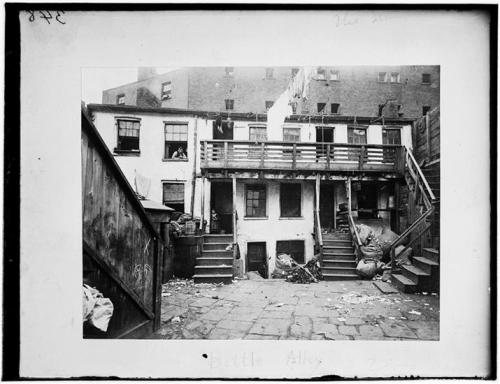
Bottle Alley. Image Via Museum of the City of New York.
A Lineage of Crime
The Dead Rabbits, the Roach Guards, the Whyos, The Five Pointers and eventually the Mafia all called Mulberry Bend home. During the Civil War, the Dead Rabbits, an Irish street gang, headquartered their gang on Mulberry Street, where they committed many depredations during the Draft Riots. By the 1870s, a gang called the Whyos, known for their call “Why-o”, dominated Mulberry Street and much of the Five Points. Naturally, the warrens of Mulberry Bend became their homeland. According to Herbert Ashbury:
“The Whyos maintained their principal rendezvous in Mulberry Bend, slightly north and east of the Five Points proper…”–Herbet Ashbury, Gangs of New York
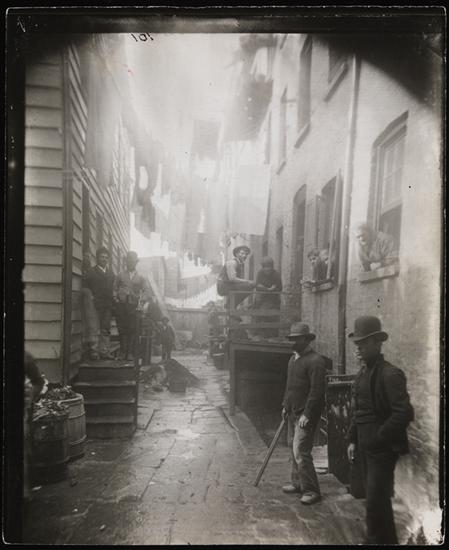
Bandits Roost. Image via the Museum of The City of New York.
As demographics changed around the turn of the century from Irish to Italian, the Mafia emerged as lords of the Bend, but their reign would not last long. Appalled by the horrid conditions, the infant mortality rate and the rampant murder, photo-journalist Jacob Riis declared war on the slums with an unknown technological advancement, the camera.
Jacob Riis: Photo-Reformer
Armed with nothing more than his camera, Riis explored the back alleys, saloons and rear tenements, documenting the squalor of the Bend and other slums. Riis published his work in a landmark text titled: How the Other Half Lives. A best seller, Riis’ book led to the demolition of Mulberry Bend.

Photo journalist and social reformer, Jacob Riis, revealed the horrors of The Mulberry Bend.
The End of Mulberry Bend: Columbus Park
In 1897, the city completely demolished Mulberry Bend, except for a tiny sliver of land. In its place, the city erected the Five Points Park, hoping that the clean air and grass would reduce crime and give children a play to play. The largely Italian population of Mulberry Street renamed the park Columbus Park in 1910.
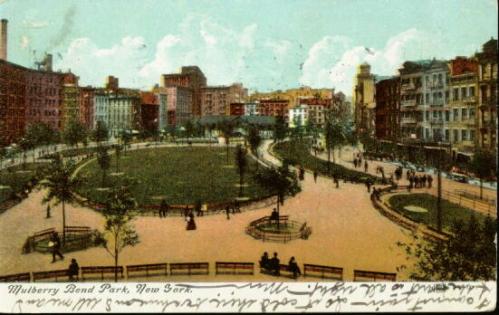
The city demolished Mulberry Bend in 1897 and created Mulberry Bend Park which was later renamed Columbus Park.

